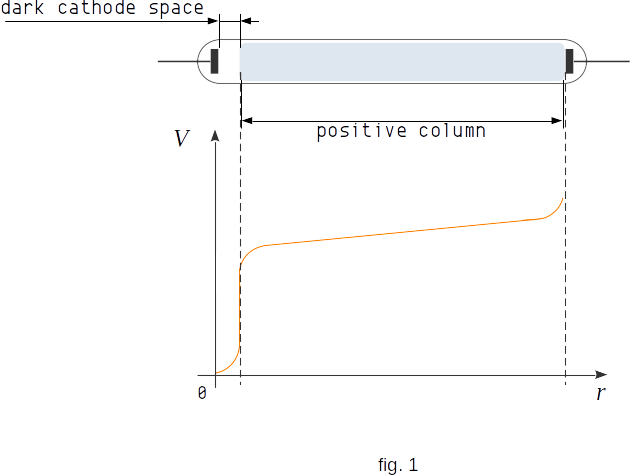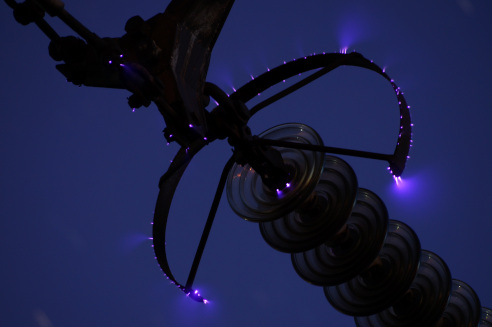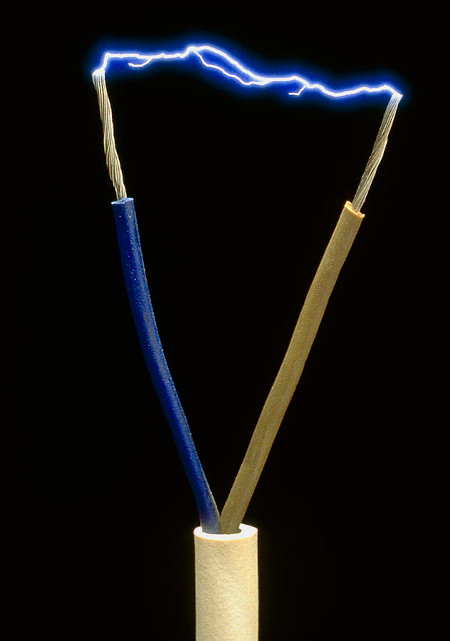From the Electrical current in different environments
109. Different types of independent discharge
Depending on the properties and condition of the gas, the type and location of the electrodes, as well as on the voltage applied to the electrodes, different types of independent discharge in gases occur.
Glow discharge.
The lower the pressure in the gas, the greater the average distance between its atoms. Therefore, as the pressure in the gas decreases, the free path of electrons between two successive collisions with atoms increases. According to formula \((10-12)\) this means increase of kinetic energy of the electron before the next collision and, consequently, its ionizing capacity.
Therefore, it is easier to excite an independent discharge in the tube at low pressures (tenths of a millimeter of a mercury column). For this purpose, the potential difference between electrodes of several hundred volts (and sometimes much less) is enough. Under these conditions, a so-called glow discharge occurs in the tube.
A direct observation of the glow discharge shows that it is not uniform. If we do not pay attention to the fine details of the structure of the discharge, we can distinguish two main areas. Directly adjacent to the cathode is an unlit area called the dark cathode space. The rest of the tube is filled with a uniform smoldering glow, the positive column.
The shock ionization occurs in the positive column area (a small number of ions is always present in any gas). The electrons generated by the ionization are directed to the anode, while the positive ions rush to the cathode and knock out electrons. The region of dark cathode space has dimensions equal to the length of free path of the electron, so electrons pass this region without collisions. Here they gather enough energy for ionization of neutral atoms.
Moving to the cathode massive ions pass the dark cathode space area in much longer time than fast and light electrons. As a result, a positive cloud of volume charge is formed near the cathode. At short distance the potential changes sharply from the minimum value at the negatively charged cathode to the maximum value in the region of positive cloud of volume charge. This sharp change of potential is called cathodic because it occurs near the cathode (fig. 1). It is in the region of cathode potential change that positive ions gain enough energy to knock out electrons from cathode surface. Presence of cathode potential change is the most important sign of glow discharge.
Glow discharge is used in advertising tubes. Red glow occurs when the tube is filled with neon. The positive column in argon has a bluish-greenish color. Daylight bulbs use a discharge in mercury vapour. The most important application glow discharge received in quantum light sources - gas lasers.

Corona discharge.
Under atmospheric pressure, a discharge is observed in highly heterogeneous electric fields, the glowing area of which often resembles a corona.
The higher the density of the charge on the surface of the conductor, the greater its curvature. At the edge, the density of the charge is maximum. This is why a strong electric field is created near the edge. When its strength exceeds \(~ 3 \cdot 10^6 \,V/m\), a discharge will occur. At this high field strength, ionization by electronic shock occurs at atmospheric pressure. As it gets away from the surface of the conductor, the strength decreases rapidly. Therefore, ionization and the gas glow associated with it are observed in a limited area of space.

A charged lightning cloud induces electrical charges of the opposite sign on the surface of the Earth. Especially large charges accumulate at the edges. Therefore, before the thunderstorm or during it often on the sharp edges and sharp corners of highly elevated objects flashes like tassels of light cones. Since ancient times, this glow has been called the lights of St. Elmo.
Climbers are particularly frequent witnesses of this phenomenon. Sometimes even not only metal objects, but also the ends of the hair on the head are decorated with small glowing tassels. If you raise your hand, you can feel the distinctive burning of electric charge running out of your fingers.
You have to pay attention to the corona discharge when dealing with high voltage. If there are protruding parts or very thin wires, the corona discharge may begin. This results in a leakage of electricity. The higher the voltage of a high-voltage line, the thicker the wires must be.
Electric arc.
When two carbon rods come into contact at the point of contact, an electric current generates a large quantity of heat due to the high contact resistance. The temperature rises so much that a thermo-electronic emission begins. As a result, a discharge begins to occur between the carbon electrodes as they move apart. An electric arc, a column of brightly glowing gas, appears between the carbons. The conductivity of the gas is also significant at atmospheric pressure, since the number of electrons emitted by the negative electrode is very high. Current force in a small arc reaches several amperes, and in large arcs of several hundred amperes at a potential difference of only about \(~ 50V\).

The high temperature of the cathode when the arc burns is supported by positive ions bombarding the cathode. The gas in the arc itself is also strongly heated by collisions with electrons and ions accelerated by the field. This causes a thermal ionization of the gas.
On the positive electrode of the arc a cavity - crater - is formed under the influence of bombing by electrons. The temperature in the crater at atmospheric pressure reaches \(~ 4000^0\,C\), and at a pressure of \(~ 20 \,atm \,\) exceeds \(~ 7000^0 \,C\). To imagine how big this temperature is, we should note that the Sun's surface temperature is approximately \(~6000^0 \,C\).
An electric arc can occur not only between carbon electrodes, but also between metallic electrodes.
If the current force is increased during a glowing discharge, the cathode temperature will increase by ion bombing so much that the arc will start. Thus, for an arc discharge to occur, the electrodes do not need to get close to each other beforehand.
Arc discharge is a powerful light source and is used in searchlights, projection and film cameras. Electric ovens are widely used in metallurgy, where the heat source is an arc discharge. Arc discharge is also used for welding metals.
Spark discharge.
If there is a high potential difference between the electrodes in the air at atmospheric pressure, a spark discharge occurs. In appearance, a spark discharge is a bundle of bright zigzag stripes branched off from a thin channel. The strips quickly penetrate the spark gap, extinguish and then flare up again. As air pressure increases, the field strength required to generate the spark becomes more than \(~ 3 \cdot 10^6 \,V/m\).

A spark occurs when the source power is not enough to maintain a continuous arc or glowing discharge. After the breakdown of the discharge gap, the voltage on the electrodes falls below the ignition potential because at the moment of discharge the conductivity of the gas increases sharply due to the formation of ions. As a result, the discharge stops. Then the voltage rises again, and so on.
As the power of the source increases, the spark discharge turns into an electric arc.
In the formation of a spark discharge, along with ionization by electronic shock, the ionization of the gas by the radiation of the spark itself plays a major role.
Lightning.
Lightning is an example of a giant spark discharge. Lightning occurs either between two clouds or between the cloud and the Earth. The current force in lightning reaches \(~ 500\,000.00 \,A\), and the potential difference between the cloud and the Earth is one billion volts. Single lightning discharges are very short-lived. They only last about one millionth of a second.

During heavy thunderstorms, sometimes there's a strange phenomenon of ball lightning appears. A ball lightning is a bright glowing formation that moves relatively slowly in the air. The size of a ball lightning may vary. Ball lightning with a diameter of \(~ 10-20 \,cm\,\) is more common. The duration of the ball lightning is from a fraction of a second to a few minutes. Read more for a ball lightning at National Geographic.